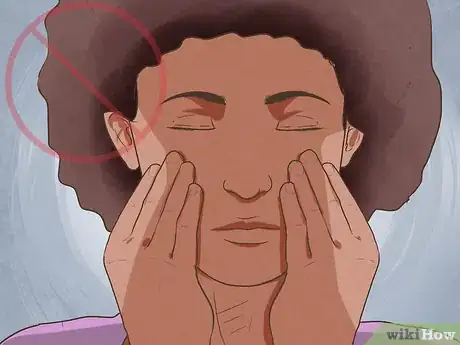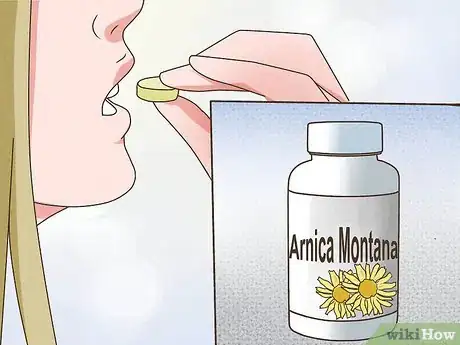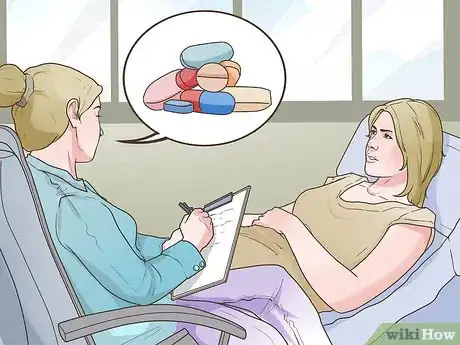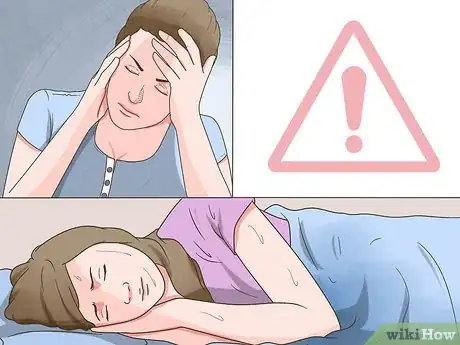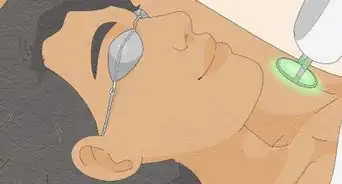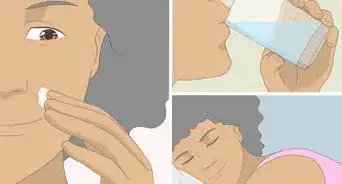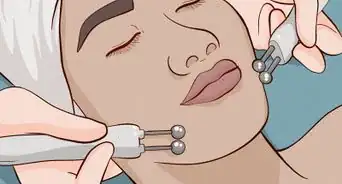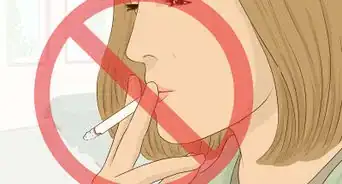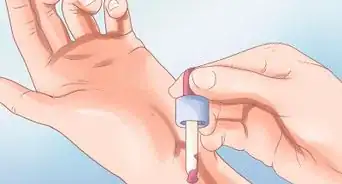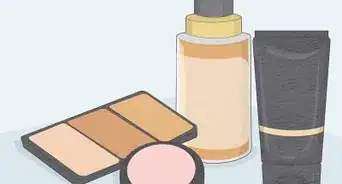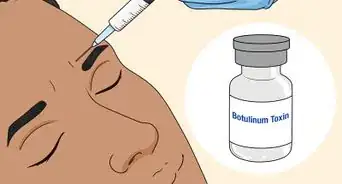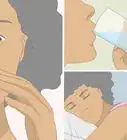This article was co-authored by Aanand Geria, MD. Dr. Aanand Geria is a board certified dermatologist, a clinical instructor at Mt. Sinai, and the owner of Geria Dermatology based in Rutherford, New Jersey. Dr. Geria's work has been featured in Allure, The Zoe Report, NewBeauty, and Fashionista, and he has peer-reviewed work for the Journal of Drugs in Dermatology, Cutis, and Seminars in Cutaneous Medicine and Surgery. He holds a BS from the Penn State University and an MD from Rutgers New Jersey Medical School. Dr. Geria then finished an internship at Lehigh Valley Health Network and a dermatology residency at the Howard University College of Medicine.
There are 16 references cited in this article, which can be found at the bottom of the page.
This article has been viewed 43,767 times.
Botox is a drug produced by a toxin in the bacterium Clostridium botulinum. Some people fear Botox because the toxin also causes botulism, a potentially life-threatening kind of food poisoning. Botox injections do not contain any bacteria and cannot give you botulism.[1] Botox is safe for most people and doctors inject small doses of it to treat health problems. It’s also used for cosmetic purposes.[2] You can prepare for your Botox treatment by taking preventative measures against stress and potential bruising. You should also care for yourself after treatment.
Steps
Getting Ready for Your Botox Appointment
-
1Schedule a time when you won’t be stressed. Any type of medical appointment can be stressful. Although most Botox appointments are over quickly, getting an injection can scare or cause anxiety in some people. Make your Botox appointment at a time that is convenient for you and won’t cause stress. Give yourself a nice cushion of time both before and after the injection so that you aren’t rushed or stressed.
- Consider scheduling your appointment in the morning. You may be less stressed and can go to the appointment when you’re relaxed after a shower or bath.
-
2Inform yourself about Botox. If you haven’t done so already, take some time to gather some information about Botox. You might want to know about the drug itself, potential risks, and review the results of others who have had Botox. Some of the most common reasons for getting Botox are:[3]
- Smoothing facial wrinkles
- Improving the appearance of your skin
- Controlling severe underarm sweating [4]
- Calming cervical dystonia, a neurological condition that causes severe muscle contraction in the neck and shoulders
- Reducing uncontrollable blinking
- Relieving strabismus, which causes misaligned eyes
- Preventing chronic migraines
- Controlling an overactive bladder.
- Preventing esophageal spasms.[5]
Advertisement -
3Avoid certain medications. Ask your doctors before the procedure what is safe or if you should avoid any medication or supplement for a certain time period before the injection. Different types of medications, such as blood thinners, NSAIDs, and muscle relaxants, can cause bleeding or bruising when used in conjunction with Botox. You may need to avoid taking these medications for about a week before your Botox treatment.[6] If you use the following medication or supplements, ask your doctor if it is safe for you to get Botox:[7]
- Blood thinners such as warfarin
- Muscle relaxants
- Sleeping aids
- Allergy medications
- Aspirin
- Ibuprofen
- St. John’s Wort
- Vitamin E
- Fish or Omega-3 oils
- Ginkgo biloba
- Ginseng
-
4Stay away from cigarettes and alcohol. Smoking before a Botox appointment can increase your risk of bruising from the injection and slow healing time. Avoid or limit smoking at least a few days before your treatment and consult with your doctor about how long is appropriate.
- You should also not drink alcoholic beverages for about 48 hours before getting a Botox injection, because it could increase your risk of bleeding or bruising.[8]
-
5Apply Arnica Montana topically. If you are especially prone to bruising, use Arnica cream before your appointment. This can reduce the risk of bruises developing at the Botox injection sites.[9] However, do not rub the injection site itself after the procedure and ask your doctor before using it.
- Don't apply arnica cream on an open wound.
- Do not take arnica orally. While homeopathic arnica preparations are available and safe to consume, they are no better than placebo in trial and the actual herb is toxic when consumed in high amounts.[10]
-
6Apply an ice pack. Using an ice pack on the area being injected with Botox can minimize possible signs of bruising from the injection. You can use the ice pack before, during, and after your procedure.
- Apply an ice pack wrapped with a towel or cloth to your skin for 20 minutes at a time. Consider icing a day before your Botox treatment. You can use a professional ice pack or make one yourself with a bag of frozen fruits or vegetables. Place a towel between the ice pack and your skin, which can prevent frostbite. Remove the pack if your skin gets too cold or feels numb.
Being Ready the Day of the Treatment
-
1Work out before the procedure. Many doctors suggest waiting at least 24 hours to exercise or exert yourself after your treatment. If you work out every day, do it before your appointment. A little physical activity can relax you before the appointment and ensure that you get in your daily workout without any stress.
-
2Cleanse your skin. Your doctor needs your skin to be free of any dirt, moisturizers, or cosmetics before your treatment. Make sure that you cleanse your skin thoroughly before your appointment and don’t apply anything until after the treatment.
- Wash your face with a mild soap or cleanser and warm water. Make sure to rinse it thoroughly to prevent any residue on your skin. Pat dry with a soft towel so you don’t irritate your skin.[11]
- Recognize that your doctor may clean your skin again with rubbing alcohol or an antiseptic cleanser before the injection to remove anything you weren’t able to wash off.
-
3Calm your nerves before the injection. Even if you exercised to help relax yourself, you may still be nervous or have anxiety before your Botox treatment. You can help relieve your nerves and anxiety by trying some of the following techniques:[12]
- Distracting yourself by talking to your doctor or a nurse
- Breathing slowly and deeply
- Listening to music
- Thinking of yourself in a calm and relaxing place such as the beach
- Trying aromatherapy
- Taking a sedative prescribed by your doctor.
-
4Be transparent with your doctor. Before your doctor injects you with Botox, he or she should consult with you. Letting him or her know about your medications, allergies, or other illnesses can help the doctor assess that it’s safe to inject you with Botox. You should also ask your doctor any questions you have about Botox or the treatment. Your doctor should know if:
- You are taking medications, supplements, and herbs
- You have allergies
- You have medical conditions, illnesses, or disease
- You have had or will have surgery, recent Botox, or other medical treatments
- You are pregnant, may be pregnant, or breastfeeding[13]
Caring For Yourself After Botox
-
1Avoid rubbing or massaging treated areas. Botox is injected into one specific site and the toxin stays in that area. Rubbing or massaging the treated area can cause the toxin to migrate, making it less effective where you need it. Keeping your fingers and hands away from the site can help your Botox treatment be more effective.[14]
- Be careful touching the skin where you had the injection.
-
2Wait 4 hours to lie down or exercise. Avoid lying down or getting physical activity for a minimum of four hours after your Botox treatment. This can help the Botox settle in the treated area and not spread to other sites.
-
3Limit alcohol consumption. You should avoid drinking alcohol or limit your consumption after having a Botox treatment. Drinking alcohol can lead to fluid retention, which may cause more bruising.
-
4Continue applying Arnica for bruising. If you were using Arnica Montana before your Botox treatment, continue your regimen after the injection, but avoid applying it to the injected site itself.
-
5Get other cosmetic procedures at least a day after Botox. If you want to get a facial, chemical peel, or microdermabrasion for your skin, make sure you schedule it at least 24 hours after your Botox treatment. This can prevent bruising and the Botox from moving to other areas of your skin.
- Make sure your doctor or aesthetician knows that you had a Botox treatment recently. He or she may suggest waiting longer than 24 hours to get your next cosmetic skin procedure.
-
6You can resume blood thinners within 24 hours following the procedure. Major studies have demonstrated that restarting blood thinners within 24 hours following the procedure is crucial to prevent thromboembolic disease in patient prone to clot formation secondary to various medical causes [15] . The bruising that develops during the injection is the only bruising you will have, as it happens secondary to needle puncturing the wall of vessel (either a vein or an artery). Once the vessel wall is sealed, which happens within minutes, it cannot rebleed secondary to blood thinners. If you are on blood thinners you can resume them within hours after the procedure [16] .
-
7Watch for side effects. If you get your Botox treatment from an experienced doctor, it is relatively safe. You may experience some side effects that you should watch closely. Let your doctor know if they don’t go away within a few days. Potential side effects you may notice are:[17]
- Pain, swelling, or bruising at the injection site
- Headache
- Flu-like symptoms
- Droopy eyelid
- Uneven eyebrows
- Crooked smile
- Drooling
- Eye dryness
- Excessive tearing
- Muscle weakness in your entire body
- Vision problems
- Trouble speaking or swallowing
- Loss of bladder control
Expert Q&A
-
QuestionWhat are the dos and don'ts of Botox?
 Aanand Geria, MDDr. Aanand Geria is a board certified dermatologist, a clinical instructor at Mt. Sinai, and the owner of Geria Dermatology based in Rutherford, New Jersey. Dr. Geria's work has been featured in Allure, The Zoe Report, NewBeauty, and Fashionista, and he has peer-reviewed work for the Journal of Drugs in Dermatology, Cutis, and Seminars in Cutaneous Medicine and Surgery. He holds a BS from the Penn State University and an MD from Rutgers New Jersey Medical School. Dr. Geria then finished an internship at Lehigh Valley Health Network and a dermatology residency at the Howard University College of Medicine.
Aanand Geria, MDDr. Aanand Geria is a board certified dermatologist, a clinical instructor at Mt. Sinai, and the owner of Geria Dermatology based in Rutherford, New Jersey. Dr. Geria's work has been featured in Allure, The Zoe Report, NewBeauty, and Fashionista, and he has peer-reviewed work for the Journal of Drugs in Dermatology, Cutis, and Seminars in Cutaneous Medicine and Surgery. He holds a BS from the Penn State University and an MD from Rutgers New Jersey Medical School. Dr. Geria then finished an internship at Lehigh Valley Health Network and a dermatology residency at the Howard University College of Medicine.
Board Certified Dermatologist Do: Schedule your appointment carefully. It's a good idea to schedule your Botox injections for a time when you don't have anything important coming up for about a week or two. Botox can cause some bruising for some people. Don't: Exercise right away. Working out immediately after your Botox injection could potentially cause the medication to diffuse under your skin, which could cause unintended side effects like drooping eyebrows or eyelids.
Do: Schedule your appointment carefully. It's a good idea to schedule your Botox injections for a time when you don't have anything important coming up for about a week or two. Botox can cause some bruising for some people. Don't: Exercise right away. Working out immediately after your Botox injection could potentially cause the medication to diffuse under your skin, which could cause unintended side effects like drooping eyebrows or eyelids. -
QuestionWhat should I do before getting Botox?
 Aanand Geria, MDDr. Aanand Geria is a board certified dermatologist, a clinical instructor at Mt. Sinai, and the owner of Geria Dermatology based in Rutherford, New Jersey. Dr. Geria's work has been featured in Allure, The Zoe Report, NewBeauty, and Fashionista, and he has peer-reviewed work for the Journal of Drugs in Dermatology, Cutis, and Seminars in Cutaneous Medicine and Surgery. He holds a BS from the Penn State University and an MD from Rutgers New Jersey Medical School. Dr. Geria then finished an internship at Lehigh Valley Health Network and a dermatology residency at the Howard University College of Medicine.
Aanand Geria, MDDr. Aanand Geria is a board certified dermatologist, a clinical instructor at Mt. Sinai, and the owner of Geria Dermatology based in Rutherford, New Jersey. Dr. Geria's work has been featured in Allure, The Zoe Report, NewBeauty, and Fashionista, and he has peer-reviewed work for the Journal of Drugs in Dermatology, Cutis, and Seminars in Cutaneous Medicine and Surgery. He holds a BS from the Penn State University and an MD from Rutgers New Jersey Medical School. Dr. Geria then finished an internship at Lehigh Valley Health Network and a dermatology residency at the Howard University College of Medicine.
Board Certified Dermatologist For about a week ahead of time, don't take anything that's going to make you more likely to bleed, like NSAIDs. Avoid alcohol for 48 hours as well, as it can make you bleed. Don't work out the same day you have Botox, and don't lie down for about 4 hours afterward, either.
For about a week ahead of time, don't take anything that's going to make you more likely to bleed, like NSAIDs. Avoid alcohol for 48 hours as well, as it can make you bleed. Don't work out the same day you have Botox, and don't lie down for about 4 hours afterward, either.
Warnings
- Seek immediate medical attention if you experience any of the following symptoms after a Botox treatment: muscle weakness in your entire body, vision problems, trouble speaking or swallowing, loss of bladder control.[18]⧼thumbs_response⧽
References
- ↑ http://www.rxlist.com/botox-side-effects-drug-center.htm
- ↑ https://medlineplus.gov/botox.html
- ↑ https://medlineplus.gov/botox.html
- ↑ https://pubmed.ncbi.nlm.nih.gov/25152343/
- ↑ http://emedicine.medscape.com/article/174975-treatment?pa=6BU90EYB24hnNcgd6DEkG8RWRhJgS1WyC6NWhMCXgn%2BaXZq0L2CNbLYcoG713NnGxfLMNjiGJNXZZa1Amzrw7G8OxiDO6aXcc0JeYePWHqw%3D#d7
- ↑ Aanand Geria, MD. Board Certified Dermatologist. Expert Interview. 8 July 2020.
- ↑ http://www.mayoclinic.org/tests-procedures/botox/details/how-you-prepare/ppc-20196387
- ↑ Aanand Geria, MD. Board Certified Dermatologist. Expert Interview. 8 July 2020.
- ↑ http://www.ncbi.nlm.nih.gov/pmc/articles/PMC3760599/
- ↑ https://www.ncbi.nlm.nih.gov/pmc/articles/PMC539394/
- ↑ http://www.mayoclinic.org/diseases-conditions/acne/basics/symptoms/con-20020580
- ↑ http://www.ncbi.nlm.nih.gov/pubmedhealth/PMH0072741/
- ↑ https://medlineplus.gov/botox.html
- ↑ http://www.mayoclinic.org/tests-procedures/botox/details/what-you-can-expect/rec-20196396
- ↑ https://www.uptodate.com/contents/perioperative-management-of-patients-receiving-anticoagulants/
- ↑ https://onlinelibrary.wiley.com/doi/full/10.1002/lary.26991
- ↑ http://www.mayoclinic.org/tests-procedures/botox/details/risks/cmc-20196372
- ↑ http://www.mayoclinic.org/tests-procedures/botox/details/risks/cmc-20196372











